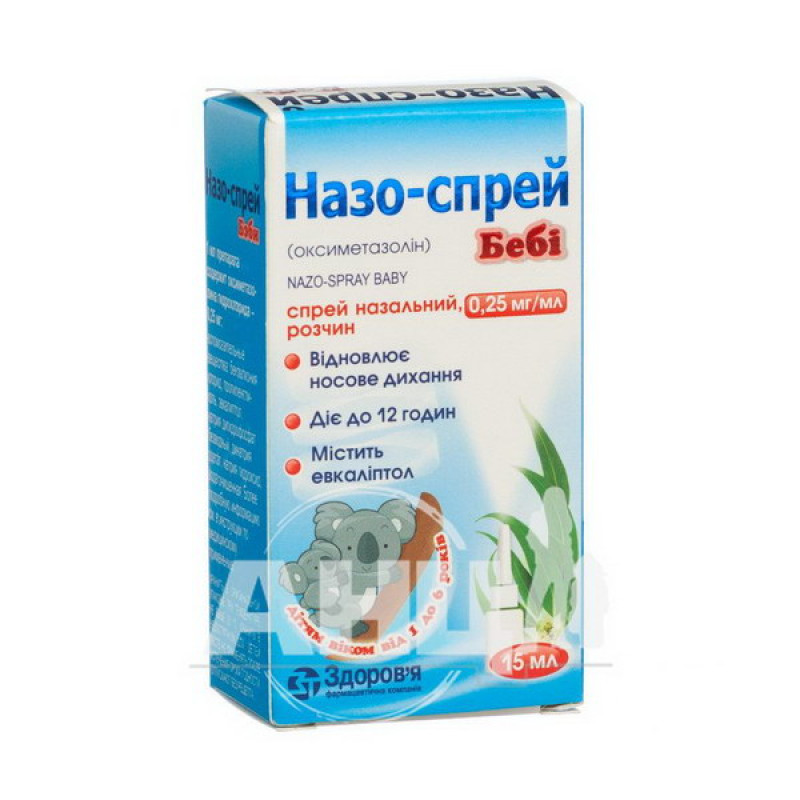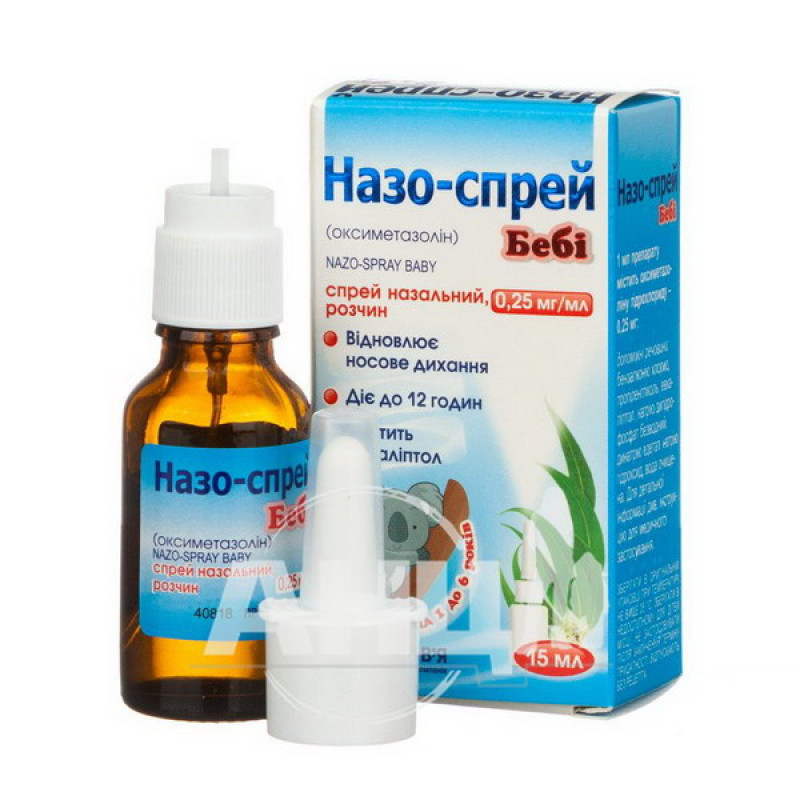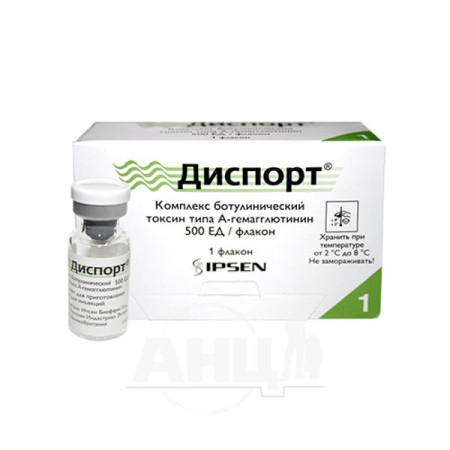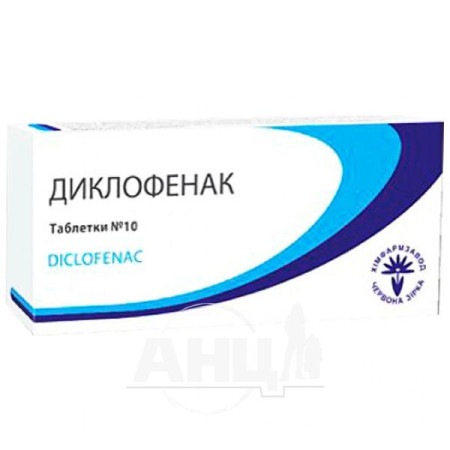oxymetazoline
Code: R01A A05
Agents acting on the respiratory system (R)
Composition of the medicinal product:
active ingredient: oxymetazoline;
1 ml of the drug contains oxymetazoline hydrochloride 0.25 mg;
Excipients: benzalkonium chloride, propylene glycol, eucalyptol, sodium dihydrogen phosphate anhydrous, disodium edetate, purified water.
Dosage form.
Nasal spray, solution.
Transparent, colorless or slightly yellowish solution with a specific odor.
Name and location of the manufacturer.
LLC "Pharmaceutical Company" Zdorovya ".
Ukraine, 61013, Kharkiv, Shevchenko St., 22.
Pharmacotherapeutic group.
Anti-edematous and other drugs for local use in diseases of the nasal cavity. Sympathomimetics. ATC code R01A A05.
Naso-spray Baby belongs to the group of local vasoconstrictors. When administered into the nasal cavity, the drug constricts the arterioles of the nasal mucosa, resulting in reduced edema, hyperemia, exudation, restored nasal breathing, and reduced nasal discharge. Naso-spray Baby reduces edema of the mucous membrane around the opening of the Eustachian tube, improving drainage in eustachitis and otitis media. The essential oils included in the drug help eliminate the feeling of irritation of the nasal mucosa, protect it from excessive drying. Local narrowing of the vessels of the nasal mucosa and paranasal sinuses lasts for 10-12 hours.
With local intranasal application, oxymetazoline is practically not subject to systemic absorption, therefore its concentration in blood plasma is insignificant.
Indications for use.
- Acute respiratory diseases accompanied by nasal congestion (acute rhinitis).
- Allergic rhinitis.
- Vasomotor rhinitis.
- To restore drainage and nasal breathing in diseases of the paranasal sinuses of the nasal cavity, eustachitis.
- To eliminate edema before diagnostic manipulations in the nasal passages.
Contraindication.
Hypersensitivity to the components of the drug, atrophic rhinitis.
The use of the drug is possible only after a careful benefit/risk assessment in:
- use of monoamine oxidase inhibitors (MAO) and other drugs that contribute to an increase in blood pressure;
- increased intraocular pressure, especially in angle-closure glaucoma;
- severe forms of cardiovascular diseases (such as coronary heart disease, arterial hypertension);
- pheochromocytoma;
- metabolic disorders (hyperthyroidism, diabetes mellitus).
The drug is contraindicated for use in children under 1 year of age.
Proper safety precautions during use.
The tip of the bottle nozzle is inserted into each nostril and the nozzle is pressed sharply once. During the injection, air is drawn in through the nose. Do not tilt your head back and turn the bottle over when injecting Naso-Spray Baby (the bottle is held strictly vertically). To prevent the spread of infection, do not use one bottle for several people. The duration of use of the drug should not exceed 7 days.
Special precautions.
Prolonged use and overdose of the drug should be avoided. Prolonged use of a nasal decongestant may lead to a weakening of the drug's effect. Abuse of this drug may cause mucosal atrophy and reactive hyperemia with rhinitis medicamentosa, as well as damage to the mucosal epithelium and inhibition of epithelial activity.
After using the drug, special observation is necessary for patients with chronic rhinitis and in cases of edema removal before diagnostic manipulations. Doses higher than recommended should be used only under the supervision of a physician.
Use during pregnancy or breastfeeding. Baby Naso-Spray is indicated for use in children aged 1 to 6 years.
The ability to influence the reaction speed when driving or working with other mechanisms.
Baby Nasal Spray is indicated for use in children aged 1 to 6 years. At recommended doses, the drug does not affect the reaction rate.
Children. Baby Nasal Spray is prescribed for children aged 1 to 6 years.
Method of administration and doses.
Children aged 1 to 6 years: 1 spray in each nostril 2-3 times a day for 5-7 days. The drug can be used again only after a few days. Doses higher than recommended should be used only under the supervision of a physician.
Overdose.
After a significant overdose or accidental ingestion, the following symptoms may occur: mydriasis, nausea, vomiting, cyanosis, fever, cramps, tachycardia, arrhythmia, cardiovascular failure, cardiac arrest, arterial hypertension, pulmonary edema, respiratory disorders, mental disorders.
In addition, central nervous system depression may occur, accompanied by drowsiness, decreased body temperature, bradycardia, hypotension, apnea, and possible development of coma.
Therapeutic measures in case of overdose: gastric lavage, administration of activated charcoal, ventilation of the lungs. Phentolamine is used to reduce blood pressure. Vasopressors should not be taken. If necessary, anticonvulsant therapy is indicated.
On the part of the respiratory system:
burning or dryness of the nasal mucosa, sneezing. After the effect of the drug wears off - a feeling of severe nasal congestion (reactive hyperemia). Long-term continuous use of vasoconstrictor drugs can lead to tachyphylaxis, atrophy of the nasal mucosa and reversible swelling of the nasal mucosa (rhinitis medicamentosa). These reactions can occur after 5-7 days of using the drug.
On the part of the digestive system: nausea, vomiting.
Nervous system: fatigue, headache, anxiety, dizziness, pale skin, lethargy, insomnia or drowsiness.
Cardiovascular: Topical nasal application may cause systemic effects such as palpitations, increased pulse rate, and increased blood pressure.
Interaction with other drugs and other types of interactions.
Naso-spray Baby should not be used simultaneously with other local vasoconstrictors and intranasally administered agents. With simultaneous use of oxymetazoline with MAO inhibitors and tricyclic antidepressants, an increase in blood pressure is possible.
Expiration date.
2 years.
Storage conditions.
Store in the original packaging at a temperature not exceeding 25 °C.
Keep out of reach of children.
Packaging.
Nasal spray, solution 0.25 mg/ml, 15 ml or 20 ml in bottles equipped with a pump valve, nasal spray nozzle and protective cap, in a box.
Release category: Over-the-counter.






